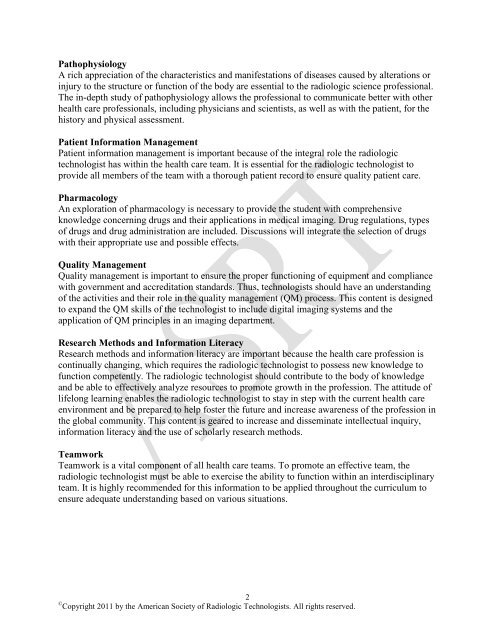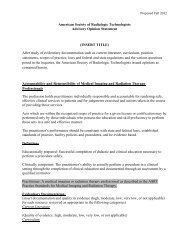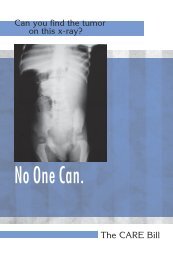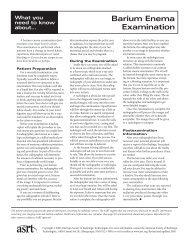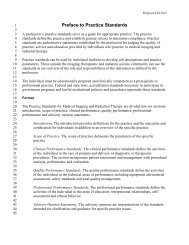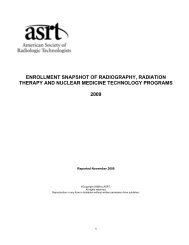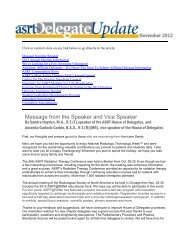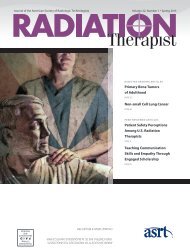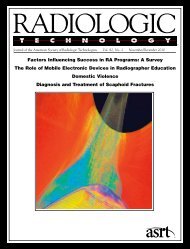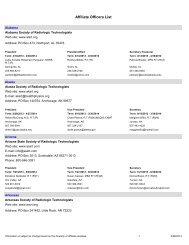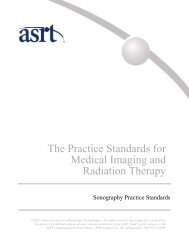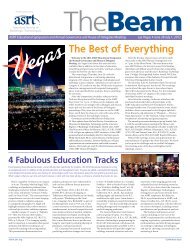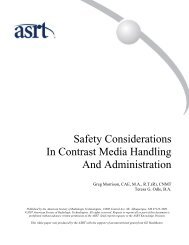Radiologist Assistant Curriculum - American Society of Radiologic ...
Radiologist Assistant Curriculum - American Society of Radiologic ...
Radiologist Assistant Curriculum - American Society of Radiologic ...
Create successful ePaper yourself
Turn your PDF publications into a flip-book with our unique Google optimized e-Paper software.
Pathophysiology<br />
A rich appreciation <strong>of</strong> the characteristics and manifestations <strong>of</strong> diseases caused by alterations or<br />
injury to the structure or function <strong>of</strong> the body are essential to the radiologic science pr<strong>of</strong>essional.<br />
The in-depth study <strong>of</strong> pathophysiology allows the pr<strong>of</strong>essional to communicate better with other<br />
health care pr<strong>of</strong>essionals, including physicians and scientists, as well as with the patient, for the<br />
history and physical assessment.<br />
Patient Information Management<br />
Patient information management is important because <strong>of</strong> the integral role the radiologic<br />
technologist has within the health care team. It is essential for the radiologic technologist to<br />
provide all members <strong>of</strong> the team with a thorough patient record to ensure quality patient care.<br />
Pharmacology<br />
An exploration <strong>of</strong> pharmacology is necessary to provide the student with comprehensive<br />
knowledge concerning drugs and their applications in medical imaging. Drug regulations, types<br />
<strong>of</strong> drugs and drug administration are included. Discussions will integrate the selection <strong>of</strong> drugs<br />
with their appropriate use and possible effects.<br />
Quality Management<br />
Quality management is important to ensure the proper functioning <strong>of</strong> equipment and compliance<br />
with government and accreditation standards. Thus, technologists should have an understanding<br />
<strong>of</strong> the activities and their role in the quality management (QM) process. This content is designed<br />
to expand the QM skills <strong>of</strong> the technologist to include digital imaging systems and the<br />
application <strong>of</strong> QM principles in an imaging department.<br />
Research Methods and Information Literacy<br />
Research methods and information literacy are important because the health care pr<strong>of</strong>ession is<br />
continually changing, which requires the radiologic technologist to possess new knowledge to<br />
function competently. The radiologic technologist should contribute to the body <strong>of</strong> knowledge<br />
and be able to effectively analyze resources to promote growth in the pr<strong>of</strong>ession. The attitude <strong>of</strong><br />
lifelong learning enables the radiologic technologist to stay in step with the current health care<br />
environment and be prepared to help foster the future and increase awareness <strong>of</strong> the pr<strong>of</strong>ession in<br />
the global community. This content is geared to increase and disseminate intellectual inquiry,<br />
information literacy and the use <strong>of</strong> scholarly research methods.<br />
Teamwork<br />
Teamwork is a vital component <strong>of</strong> all health care teams. To promote an effective team, the<br />
radiologic technologist must be able to exercise the ability to function within an interdisciplinary<br />
team. It is highly recommended for this information to be applied throughout the curriculum to<br />
ensure adequate understanding based on various situations.<br />
2<br />
© Copyright 2011 by the <strong>American</strong> <strong>Society</strong> <strong>of</strong> <strong>Radiologic</strong> Technologists. All rights reserved.


